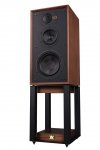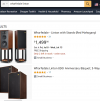- Joined
- Jan 15, 2020
- Messages
- 6,857
- Likes
- 16,804
It seems he really likes them:






















Full review link: https://www.erinsaudiocorner.com/loudspeakers/wharfedale_linton_85/
Parting / Random Thoughts
As stated in the Foreword, this written review is purposely a cliff’s notes version. For details about the performance (objectively and subjectively) please watch the YouTube video. But a couple quick notes based on my listening and what I see in the data:
Overall, point blank, one of my favorite speakers to date and I think I’d have to put this as number one in its price range. Off the top of my head, I can’t think of a better $1500/pair speaker I’ve heard to date. If I were shopping, these would be at the top of my list for speakers to demo in my home against others before I made the final decision. Make sure you try with the grille on and off and I suggest toeing them out by about 10° for best tradeoff between tonality, soundstage width and imaging.
- This is truthfully one of my favorite speakers so far. On sight, I half expected this speaker to sound quite colored and have resonances; an experience I had with the Klipsch Heresy IV. However, my subjective listening experience was the complete opposite. For the first time in a while I found myself going through an extensive number of songs and just enjoying the music. There were no “standouts” that bothered me and pulled me “out of my element”. Even upon additional listening sessions I continued to find myself more and more happy with the sound from the Lintons.
- These speakers extend to about 40Hz in my room (50Hz anechoic F3) and play with plenty of volume if you choose to crank them up. There was no screeching at high level or no graininess to the sound with increased volume. And at lower volume levels the dynamics were still there thanks to the very neutral midbass to midrange transition that didn’t call attention to itself via resonance like so many rectangle speakers tend to do.
- Construction seems good overall and I like that the midrange driver has its own enclosure inside the speaker. Not only does it have its own enclosure but the enclosure is round. Meaning there is less chance for standing waves compared to big rectangular speakers. There is also a liberal amount of insulation in the enclosure. Overall, I am really happy to see such thoughtfulness put into the build quality of this speaker.
- The soundstage width is impressive. At about ±70° through the upper midrange, it is wide but not so wide that it results in a diffuse soundstage (at least in my setups).
- Remember, the speaker performs best with the grille on.
- Stay at tweeter level. If you go even 10° above or below the tweeter level, the timbre of the speaker is noticeably different and worse.
- The treble can sound a touch bright. I played around with positioning and found that turning the speakers about 10° off-axis (firing out into the room; not cross-firing across the room) worked best to balance the HF with soundstage width.
- There really isn’t much about this speaker I’d change. The only complaint I have in my notes is in regard to the snare not having quite the “attack” I’d expect. The data shows a dip through this region so I think that’s likely what I was hearing. Therefore, I might, might consider evaluating the crossover between the midrange and tweeter and bring that down a bit, if possible just to get better directivity matching in the 1-2kHz region. But this would be a pretty low objective on my list. I’d probably never get around to it. I’d just enjoy them for what they are.
- The data shows a very linear speaker within about ±2dB above about 70Hz and an F3 of 50Hz, putting typical in-room extension to around 40Hz. Horizontal directivity looks really good until around 1-2khz where the tweeter crossover is. Sensitivity is about 85dB @ 2.83v/1m.
- Something interesting and possibly (or not at all) related to my positive listening experience: this speaker has a larger than typical front baffle width. Which means it provides more directivity at lower frequencies than many bookshelf and tower speakers. This means that the speaker is mostly radiating in the front hemisphere at a lower frequency than its slimmer counterparts.
Full review link: https://www.erinsaudiocorner.com/loudspeakers/wharfedale_linton_85/
Last edited:


